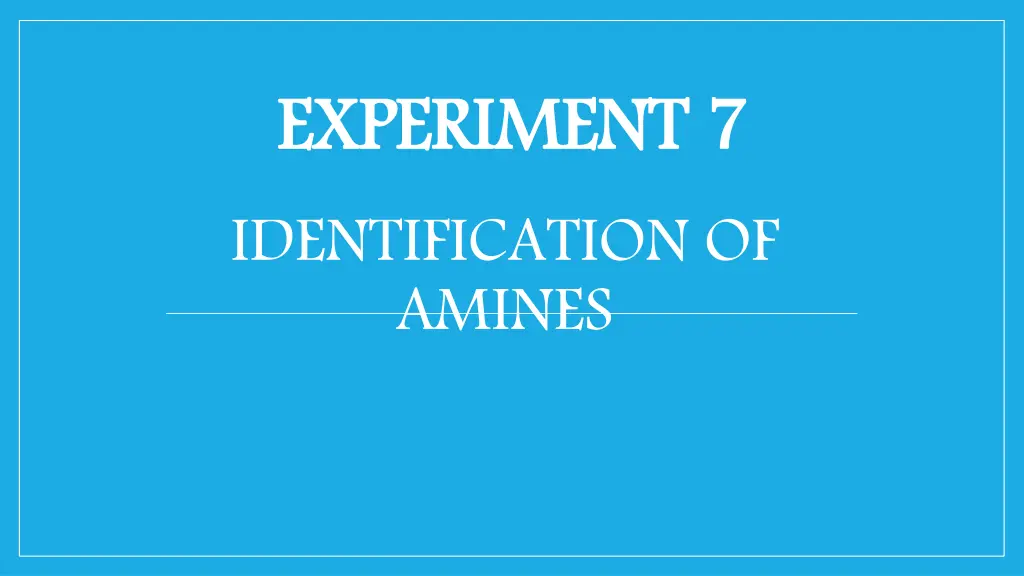
Identifying Amines: Characteristics, Biological Activity, and Chemical Reactions
Discover the world of amines in organic chemistry with this exploration of their characteristics, biological activity, and chemical reactions. Learn about their basic nitrogen atom structure, strong odors, toxic properties, and how they react in different chemical tests. Uncover the details of distinguishing between primary and secondary amines through the Hinsberg Test.
Download Presentation

Please find below an Image/Link to download the presentation.
The content on the website is provided AS IS for your information and personal use only. It may not be sold, licensed, or shared on other websites without obtaining consent from the author. If you encounter any issues during the download, it is possible that the publisher has removed the file from their server.
You are allowed to download the files provided on this website for personal or commercial use, subject to the condition that they are used lawfully. All files are the property of their respective owners.
The content on the website is provided AS IS for your information and personal use only. It may not be sold, licensed, or shared on other websites without obtaining consent from the author.
E N D
Presentation Transcript
EXPERIMENT IDENTIFICATION OF AMINES EXPERIMENT 7 7
Amines are organic compounds and functional groups that contain a basic nitrogen atom with lone pair. Amines are derivatives of ammonia, wherein one or more hydrogen atoms have been replaced a subsistent such as an alkyl or aryl group. Important amines including amino acids, biogenic amines, trimethyl amine and aniline. For aliphatic amines name groups attached to N; use suffix - amine.
Biological Activity: Amines have strong, characteristic odors, and are toxic. The smells of ammonia, old fish, urine, rotting flesh, and semen are mainly composed of amines. Many kinds of biological activity produce amines by breakdown of amino acids. Many hormones like epinephrine, nor epinephrine, and dopamine, are amines
Chemical Reactions: 1. General test (The hydrochloric acid test). Amines are characterized chiefly through their basicity. A water insoluble compound that dissolves in cold dilute hydrochloric acid or a water-soluble compound whose aqueous turn litmus blue. +Cl- NH3 NH2 + HCl Aniline Anilinium chloride
2. Tests for differentiation between. Primary and secondary amines. The Hinsberg Test . An electrophilic reagent, benzenesulfonyl chloride, reacts with amines in a fashion that provides a useful test for distinguishing primary, secondary and tertiary amines (the Hinsberg test). As shown in the following equations, 1 and 2 -amines react to give sulfonamide derivatives with loss of HCl, whereas 3 -amines do not give any isolable products other than the starting amine. In the latter case a quaternary "onium" salt may be formed as an intermediate, but this rapidly breaks down in water to liberate the original 3 - amine (lower right equation).
The Hinsberg test is conducted in aqueous base (NaOH or KOH), and the benzenesulfonyl chloride reagent is present as an insoluble oil. The amine dissolves in the reagent phase, and immediately reacts (if it is 1 or 2 ), with the resulting HCl being neutralized by the base. The sulfonamide derivative from 2 -amines is usually an insoluble solid. However, the sulfonamide derivative from1 -amines are acidic and dissolve in the aqueous base. Acidification of this solution then precipitates the sulfonamide of the 1 -amine. Benzenesulphonyl chloride reacts with primary and secondary but not with tertiary amines to yield substituted sulphonamides. The substituted sulphonamide formed from a primary amine dissolves in the alkali medium whilst that produced from a secondary amine is insoluble in alkali.






















